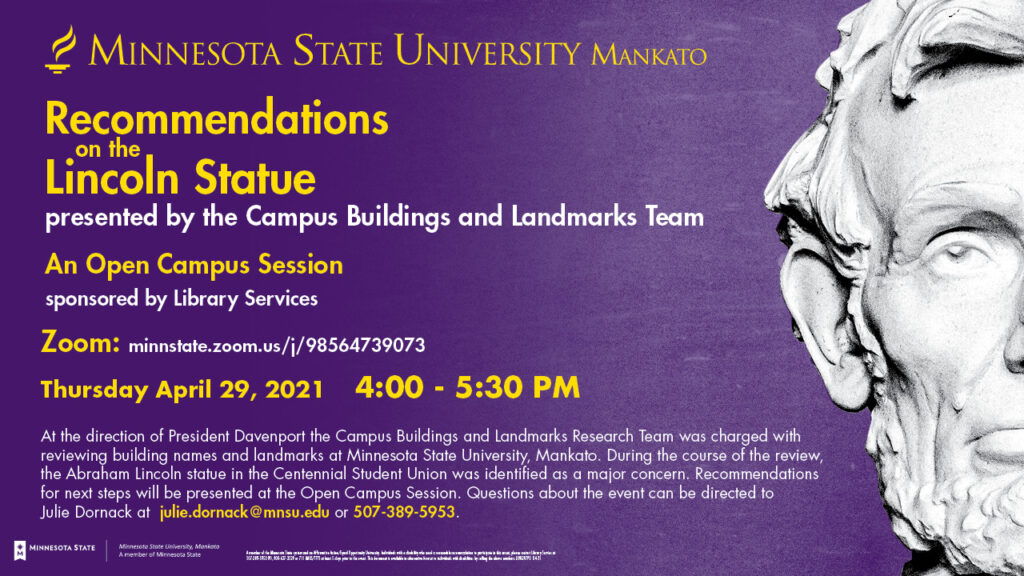
A Thursday, April 29, discussion will seek recommendations for the Abraham Lincoln statue located in the Centennial Student Union.
The open campus session sponsored by Library Services will be at 4 p.m. via zoom. To join the event, go to https://minnstate.zoom.us/j/98564739073.
At the direction of Minnesota State Mankato President Richard Davenport, the Campus Buildings and Landmarks Research Team continues reviewing building names and landmarks at Minnesota State University, Mankato. The Abraham Lincoln statue in the Centennial Student Union was identified as a major concern.
For questions or additional information contact Julie Dornack at julie.dornack@mnsu.edu or 507-389-5953.
The 7-foot Lincoln statue has been a part of the University since it first appeared on the original Valley campus in 1926. Known then as the Normal School, there was a tradition for graduating classes to donate items to the school to commemorate their academic experience. In 1922, a devastating fire destoryed the Main Hall.
The Abraham Lincoln statue was purchased as part of an alumni effort led by Dr. Hiram J. Lloyd to replace memorabilia lost in the fire.
In 1958, the first library building opened on campus was named the Lincoln Library. It seemed only fitting that the namesake statue be relocated to the second floor of the library.
Twenty years later, as the University transitioned to the upper Highland campus, the Lincoln statue moved to the Centennial Student Union where it currently stands in the Lincoln Lounge on the main level of the student union.
Over the decades, “Old Abe” has served as a common landmark. A phrase heard through the years was “Meet me at Abe Lincoln.” A target of pranksters, he has been vandalized, dressed up and had his head stolen (it is now firmly attached).
Best known for his Civil War role in freeing of the slaves and preserving the Union, Lincoln is historically fused with the Mankato region.
In 1862, as the Civil War raged on, he faced his biggest crisis involving Native Americans. The Dakota nation of southern Minnesota, on the brink of starvation after delays in promised treaty payments, rose up and killed white settlers in the region. Lincoln took a stance at the end of the Dakota War that remains controversial today.
Historical records state that when a military commission condemned 303 Dakota warriors, Lincoln personally reviewed all the trial transcripts at the request of Henry B. Whipple, Episcopal Bishop of Minnesota. After thorough examination of the cases, Lincoln commuted the sentences of all but 38 warriors. On December 26, 1862, the 38 were hanged in Mankato. It remains the largest mass execution in U.S. history.
According to historians, Lincoln’s response to the Dakota War shows a president, politician and lawyer caught in the prejudices and influences of times as well as his firm belief that law was sacrosanct. He knew injustices had been made and more would come in the form of mob violence if presidential action wasn’t taken. He decided to uphold death sentences only when evidence existed against those directly involved with the killing of civilians.
The Abraham Lincoln statue stands on a pedestal with a plaque that includes a passage from the 16th president’s famous Gettysburg Address. The plaque reads: “1809-1865: It is for us the living, rather, to be dedicated to the unfinished work.”
